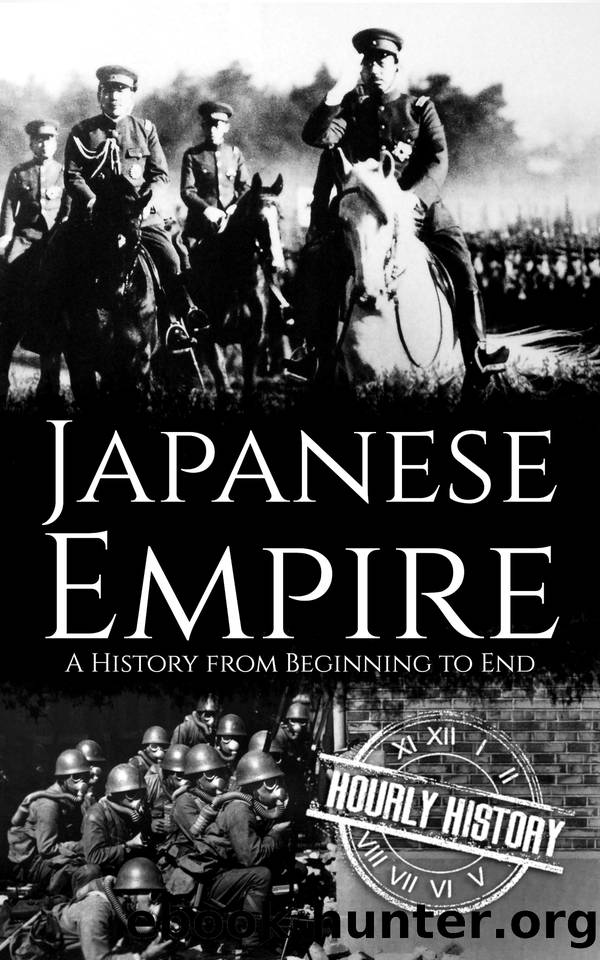Japanese Empire: A History from Beginning to End by History Hourly

Author:History, Hourly
Language: eng
Format: epub
Publisher: Hourly History
Published: 2023-04-09T00:00:00+00:00
Chapter Six
Coups and Political Violence
âAsia for the Asians.â
âJapanese slogan
During the late 1920s and the 1930s, the actions of some army and Japanese navy officers became increasingly violent and aimed at replacing the civilian administration with some form of military rule. Successive governments seemed powerless to curtail this violence. Members of the Kwantung Army had murdered a Chinese warlord, Chang Tso-lin, in 1929, but neither the Diet nor the military High Command seemed willing to risk pressing for the identification and arrest of those responsible. The government fell as a result, and the prime minister of the succeeding government, Hamaguchi Osachi, was assassinated by a young nationalist supporter in 1930 when he attempted to curtail the power of the Japanese military.
After the Japanese occupation of Manchuria, a new government was formed in December 1931, led by Prime Minister Inukai Tsuyoshi. Inukai was completely opposed to the growing power of the military and attempted to curtail further military advances in Manchuria and planned to send a Japanese envoy to China to negotiate the withdrawal of Japanese troops in the area. In May 1932, after just six months in office, Inukai was murdered by a group of ultranationalist officers from the Imperial Japanese Army.
Political murder became almost commonplace, with not just politicians but prominent business leaders being killed by various military factions. The Japanese army announced that it would no longer take orders from any party cabinet, and anyone voicing opposition to the army or navy risked attack or assassination. In an effort to restore order, a retired admiral of the navy, SaitÅ Makoto, was appointed prime minister. Yet even this did not appease the followers of KÅdÅha.
In February 1936, military members of the KÅdÅha faction attempted a coup. SaitÅ Makoto and several leading political figures were assassinated, and the plotters were able to seize control of many government buildings in Tokyo, but critically, not the imperial palace. Emperor Hirohito soon made clear his displeasure at this latest attempt at the military to take power. Faced with the condemnation of the emperor, the remainder of the army felt it had no choice but to act against the rebels. Government buildings were retaken, and the leaders of the rebellion were rounded up, tried, and quickly executed. Supporters of the KÅdÅha faction were removed from senior military positions and were replaced by members of the more moderate TÅseiha faction.
While political violence diminished following the failed coup in 1936, even members of the TÅseiha were dedicated to expanding the Japanese Empire. All were committed to the creation of a âNew Orderâ in Asia that would see the colonial possessions of European nations replaced by what would later become known as the Greater East Asia Co-Prosperity Sphere, a new confederation of Asian states controlled by Japan. In Asia, there was growing feeling against colonial rule, and the creation by Japan of what appeared to be a pan-Asian group that supported independence and freedom found many supporters in other countries. Only too late would those countries understand that this new group simply replaced colonial rule with rule by Japan.
Download
This site does not store any files on its server. We only index and link to content provided by other sites. Please contact the content providers to delete copyright contents if any and email us, we'll remove relevant links or contents immediately.
18 real-life stories of serial killers and murderers with solved and unsolved killings from the USA, UK, Europe, and beyond. by Ben Oakley(171)
Who's Who in the Zulu War, 1879: The British by Adrian Greaves Ian Knight(165)
Design, construction, and validation of optogenetic proteins by Colin P. O'Banion & Anwesha Goswami & David S. Lawrence(114)
The Battle of Austerlitz by 50minutes(113)
Interest and Connection in the Eighteenth Century by Jacob Sider Jost(110)
The Seeker by S. G. MacLean(110)
Fires of Faith by Catholic England under Mary Tudor(108)
The Origins of French Absolutism, 1598-1661 by Alan James(105)
Invisible Worlds by Peter Marshall(103)
The Slave Trade in Africa by Simon Webb;(101)
Medicine in Modern Britain 1780-1950 by Deborah Brunton(96)
Islam and the Trajectory of Globalization by Louay M. Safi(95)
A Genius for Confusion by Richard M. Fried(94)
Witchcraft in Early Modern England by James Sharpe(94)
A Cultural History of Theatre in the Age of Enlightenment by Leon Mechele;(94)
The Thirty Years War â Complete by Friedrich Schiller(91)
Practices of Diplomacy in the Early Modern World c.1410-1800 by Tracey A. Sowerby Jan Hennings(87)
Pentecostal Republic by Ebenezer Obadare(87)
Married Women in Legal Practice by Charlotte Cederbom(81)
